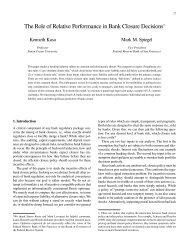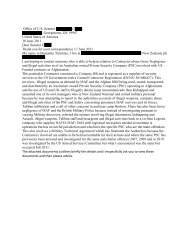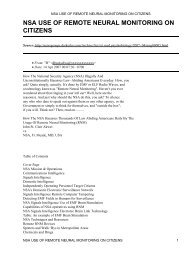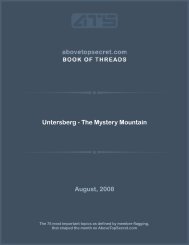If Stewart came back today, he would have to revise this statement after reading UFO material.Reverend Kirk stated the case more clearly when he said: "In our Scotland there are numerous andbeautiful creatures <strong>of</strong> that aerial order, who frequently assign meetings to lascivious young men assuccubi, or as joyous mistresses and prostitutes, who are called Leannain Sith or familiar spirits. "Ihardly need to remind the reader <strong>of</strong> the importance <strong>of</strong> such "familiar spirits" in medieval occultism,particularly in Rosicrucian theories. Nor do I need to mention the number <strong>of</strong> accused witches whowere condemned to death on the evidence that they had such familiar spirits. Like the modernabductees examined by Budd Hopkins, the women accused <strong>of</strong> witchcraft usually had a strange markor scar somewhere on their body.There is no gap between the fairy-faith and ufology regarding the sexual question. This is apparentfrom the study made by Evans-Wentz, who records the following story:My grandmother Catherine MacInnis used to tell about a man named Laughlin, whom sheknew, being in love with a fairy-woman. The fairy-woman made it a point to see Laughlinevery night, and he being worn out with her began to fear her. Things got so bad at last thathe decided to go to America to escape the fairy-woman. As soon as the plan was fixed andhe was about to emigrate, women who were milking at sunset out in the meadows heardvery audibly the fairy-woman singing this song:What will the brown-haired woman doWhen Lachie is on the billows?Lachie emigrated to Cape Breton, landing at Pictu, Nova Scotia; and in his first letter hometo his friends he stated that the same fairy-woman was haunting him there in America.The comments by Evans-Wentz on this case are important:To discover a tale so rare and curious as this... is certainly <strong>of</strong> all our evidence highlyinteresting. And aside from its high literary value, it proves conclusively that the fairywomenwho entice mortals to their love in modern times are much the same, if not the same,as the succubi <strong>of</strong> middle-age mystics.This allows us to return to the religious records mentioned above, which <strong>of</strong>fer some <strong>of</strong> the mostremarkable cases <strong>of</strong> apparition I have ever come across. It is difficult to believe that stories existthat surpass, for their amazing contents or shocking features, some <strong>of</strong> the reports we have alreadystudied, such as the Hills' case or the Villas-Boas report. But, remarkable as they are, these lattertwo accounts refer only to one aspect <strong>of</strong> the total phenomenon; they can be interpreted only afterbeing placed within the continuum <strong>of</strong> hundreds <strong>of</strong> lesser-known cases, which provide the necessarybackground.A book by Isidore Liseux, attributed by him to a theologian named Sinistrari, shows that churchscholars were as puzzled by reports <strong>of</strong> incubi and succubi as most modern students <strong>of</strong> UFO lore areby the Villas-Boas case. Observing that the fundamental texts <strong>of</strong> the church gave no clear opinionon such cases, the author wondered how they should be judged by religious law. There arenumerous cases in the records <strong>of</strong> the church (especially in witch trials) in which intercourse withincubi is found. From the church's point <strong>of</strong> view, this raises several problems. First, how is suchintercourse physically possible? Second, how does demoniality differ from bestiality? Third, whatsin is committed by those who engage in such intercourse? Fourth, what should their punishmentbe?The earliest author who uses the word demonialitas is J. Caramuel, in his TheologiaFundamentalis. Before him, no one made a distinction between demoniality and bestiality. All themoralists, following St. Thomas Aquinas, understood by bestiality "any kind <strong>of</strong> carnal intercoursewith an object <strong>of</strong> a different species." Thus Cajetan in his commentary on St. Thomas places
intercourse with the demon in the class <strong>of</strong> bestiality, and so does Sylvester when he definesLuxuria, and Bonacina in De Matrimonio.In this respect, Villas-Boas's remark that lying with the woman gave him the impression he waslying with an animal, because <strong>of</strong> her "growls," is striking.On this fine point <strong>of</strong> theology Sinistrari concludes that St. Thomas never meant intercourse withdemons to fall within his definition <strong>of</strong> bestiality. By different species, Sinistrari says, the saint canonly mean species <strong>of</strong> living beings, and this hardly applies to the devil. Similarly, if a man copulateswith a corpse, this is not bestiality, especially according to the Thomist doctrine that denies a corpsethe nature <strong>of</strong> the human body. The same would be true for a man who copulates with the corpse <strong>of</strong>an animal. It is quite fascinating to follow Sinistrari's thoughts in an area that is directly relevant toUFO reports: Villas-Boas would certainly have had a hard time before the Inquisitors if he had livedin an earlier age. Indeed, a man named Benoît de Berne, who confessed at age seventy-five that hehad had intercourse for forty years with a succuba named Mermeline, was condemned and burnedalive.The act <strong>of</strong> love, writes Sinistrari, has for its object human generation. Unnatural semination, that is,intercourse that cannot be followed by generation, constitutes a sin against nature. But it is thesubject <strong>of</strong> that semination that distinguishes the various sins under that type. If demoniality andbestiality were in the same category, a man who had copulated with a demon could simply tell hisconfessor: "I have committed the sin <strong>of</strong> bestiality." And yet he obviously has not committed that sin.Considerable problems arose when one had to identify the physical process <strong>of</strong> intercourse withdemons. This is clearly a most difficult point (as difficult as that <strong>of</strong> identifying the physical nature<strong>of</strong> flying saucers!), and Sinistrari gives a remarkable discussion <strong>of</strong> it. Pointing out that the mainobject <strong>of</strong> the discussion is to determine the degree <strong>of</strong> punishment these sins deserve, he tries to listall the different ways in which the sin <strong>of</strong> demoniality can be committed. First he remarks:There are quite a few people, over-inflated with their little knowledge, who dare deny whatthe wisest authors have written, and what everyday experience demonstrates: namely, thatthe demon, either incubus or succubus, has carnal union not only with men and women butalso with animals.Sinistrari does not deny that some young women <strong>of</strong>ten have visions and imagine that they haveattended a sabbat. Similarly, ordinary erotic dreams have been classified by the church quiteseparately from the question we are studying. Sinistrari does not mean such psychologicalphenomena when he speaks <strong>of</strong> demoniality; he refers to actual physical intercourse, such as thebasic texts on witchcraft discuss. Thus in the Compendium Maleficarum, Gnaccius gives eighteencase histories <strong>of</strong> witches who have had carnal contact with demons. All cases are vouched for byscholars whose testimony is above question. Besides, St. Augustine himself says in no uncertainterms:It is a widespread opinion, confirmed by direct or indirect testimony <strong>of</strong> trustworthy persons,that the Sylvans and Fauns, commonly called Incubi, have <strong>of</strong>ten tormented women, solicitedand obtained intercourse with them. There are even Demons, which are called Duses [i.e.,lutins] by the Gauls, who are quite frequently using such impure practices: this is vouchedfor by so numerous and so high authorities that it would be impudent to deny it.Now the devil makes use <strong>of</strong> two ways in these carnal contacts. One he uses with sorcerers andwitches, the other with men and women perfectly foreign to witchcraft.What Sinistrari is saying here is that two kinds <strong>of</strong> people may come in contact with the beings hecalls demons: those who have made a formal pact with them – and he gives the details <strong>of</strong> theprocess for making this pact – and those who simply happen to be contacted by them. Theimplications <strong>of</strong> this fundamental statement <strong>of</strong> occultism for the interpretation <strong>of</strong> the fairy-faith and<strong>of</strong> modern UFO stories should be obvious.
- Page 3 and 4:
Foreword by Whitley StrieberThere a
- Page 5 and 6:
It is sad that, as the twentieth ce
- Page 7 and 8:
PART ONE: THE ALIEN CHRONICLESIn th
- Page 9 and 10:
lot about it, but nobody said 'Let'
- Page 11 and 12:
The resemblance of the Dogu statues
- Page 13:
various forms of error worship unde
- Page 16 and 17:
them. These apparitions are scarce,
- Page 18 and 19:
was again shot at. Another creature
- Page 20 and 21:
The story is fantastic. Yet it remi
- Page 22 and 23:
their virginity in the sanctuaries
- Page 24 and 25:
A letter from a British woman begin
- Page 26 and 27:
The recollections of the legionnair
- Page 28 and 29: lades. In less time than it takes t
- Page 30 and 31: e called Smith said: "No, we cannot
- Page 32 and 33: Celtic legends, along with the docu
- Page 34 and 35: probably took place in the second p
- Page 36 and 37: Australian Air Force Intelligence p
- Page 38 and 39: ings in the fields and prairies?One
- Page 40 and 41: From behind the object, two beings
- Page 42 and 43: "in smooth English." They did not s
- Page 44 and 45: to four feet tall, dressed in white
- Page 46 and 47: expectations as if they were mere t
- Page 48 and 49: came out of it, but this person was
- Page 50 and 51: 6. When men did not inhabit most of
- Page 52 and 53: the negative reactions of scientist
- Page 54 and 55: other in appearance, dress, mode of
- Page 56 and 57: saw that they had made a grin, he h
- Page 58 and 59: and rode out after dark in search o
- Page 60 and 61: sighting, and the Sonny Desvergers
- Page 62 and 63: PART TWO: ANOTHER REALITYDuring the
- Page 64 and 65: pencil in a buttonhole with a piece
- Page 66 and 67: short perpendicular line on each en
- Page 68 and 69: sudden displacement of warm air or
- Page 70 and 71: popular today. But a second - and e
- Page 72 and 73: ecorded about 1825 in the Vale of N
- Page 74 and 75: The ikal of the Tzotzils flies thro
- Page 76 and 77: the door, he turned and recieved a
- Page 80 and 81: The devil does not have a body. The
- Page 82 and 83: interested in the social implicatio
- Page 84 and 85: Very well, little son. Come back to
- Page 86 and 87: measure. But the phenomenon does ap
- Page 88 and 89: and physical, to determine whether
- Page 90 and 91: previous year. But the fact remains
- Page 92 and 93: Do Not Report This!Accounts such as
- Page 94 and 95: least one occasion, experienced lev
- Page 96 and 97: deep unconscious level of the symbo
- Page 98 and 99: much as twenty hours a day, and in
- Page 100 and 101: against me as I stood bracing mysel
- Page 102 and 103: another one, but this was very defi
- Page 104 and 105: not natural, was witnessed by perso
- Page 106 and 107: The predicted miracle took place as
- Page 108 and 109: The phenomenon, it seems, could not
- Page 110 and 111: in the final analysis.Many of us wi
- Page 112 and 113: already surrounded....I was told wh
- Page 114 and 115: Since the publication of my earlier
- Page 116 and 117: ”A bright flash”Fatima, May 13,
- Page 118 and 119: The Invisible CollegeAfter some thi
- Page 120 and 121: the Air Force met in Dallas and dis
- Page 122 and 123: panel of scientists could rapidly b
- Page 124 and 125: it had been hovering there was now
- Page 126 and 127: like piezo-electricity, or static e
- Page 128 and 129:
the group teachings and advice. The
- Page 130 and 131:
This is a frightening view, one tha
- Page 132 and 133:
John McCoy, who coauthored with Wil
- Page 134 and 135:
of reports about "the robots" and "
- Page 136 and 137:
eathe our air. They walked normally
- Page 138 and 139:
the designation Wolf 424.The myster
- Page 140 and 141:
a scar or a mark. The authorities w
- Page 142 and 143:
esearches might have a bearing on a
- Page 144 and 145:
me undeniable) and as psychic devic
- Page 146 and 147:
extraterrestrial theory is not stra
- Page 148 and 149:
the universe summarizes the problem
- Page 150 and 151:
About the AuthorAn astrophysicist b
















